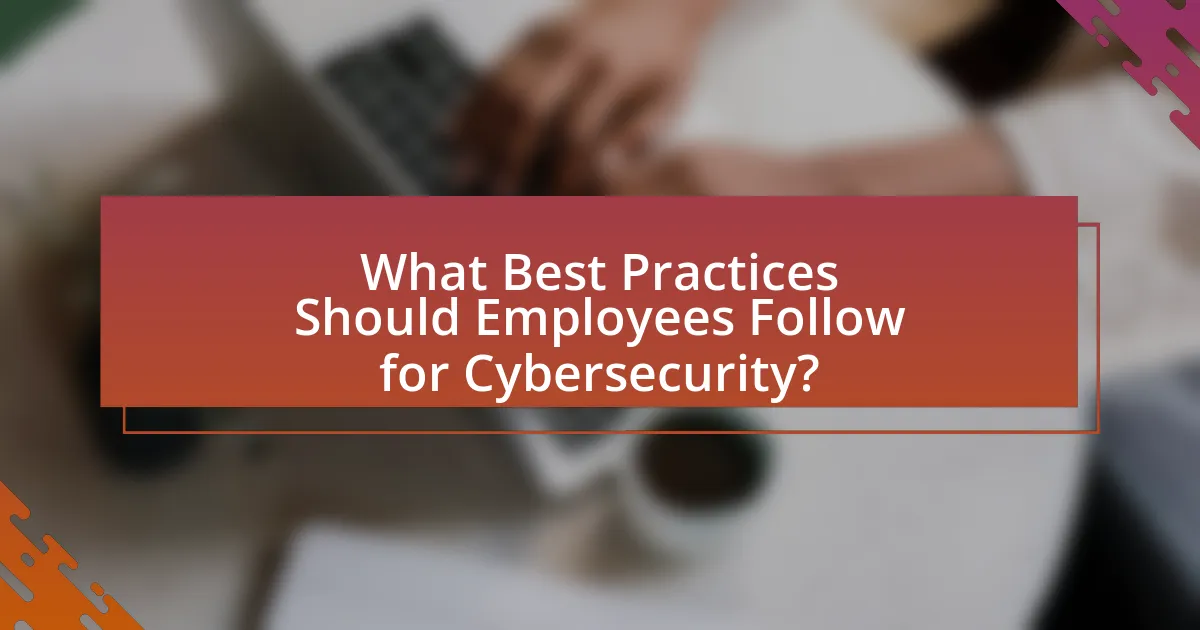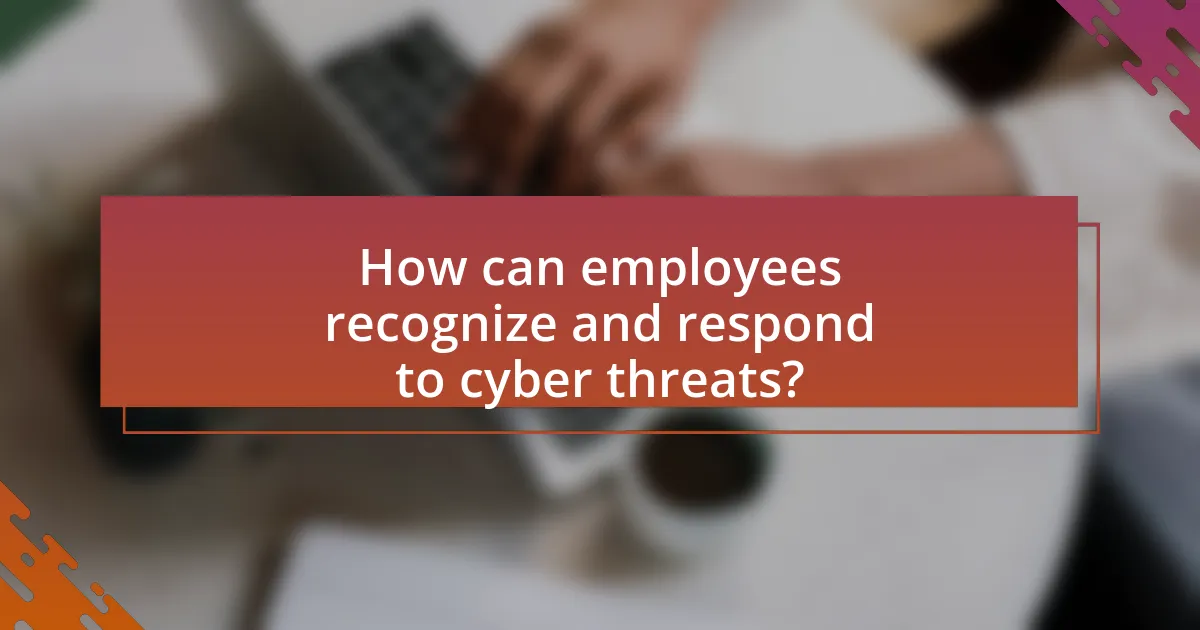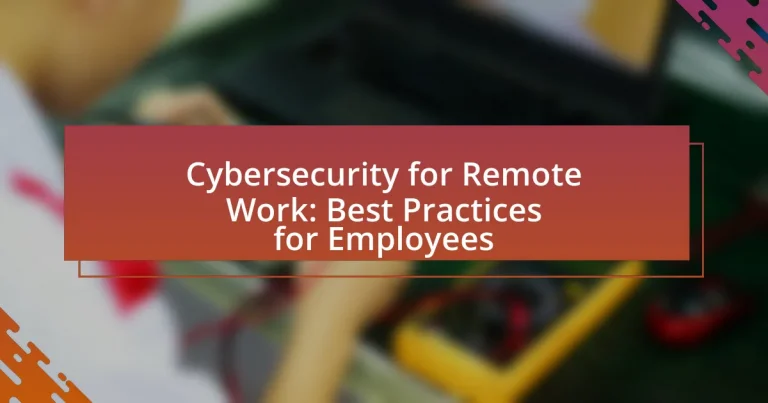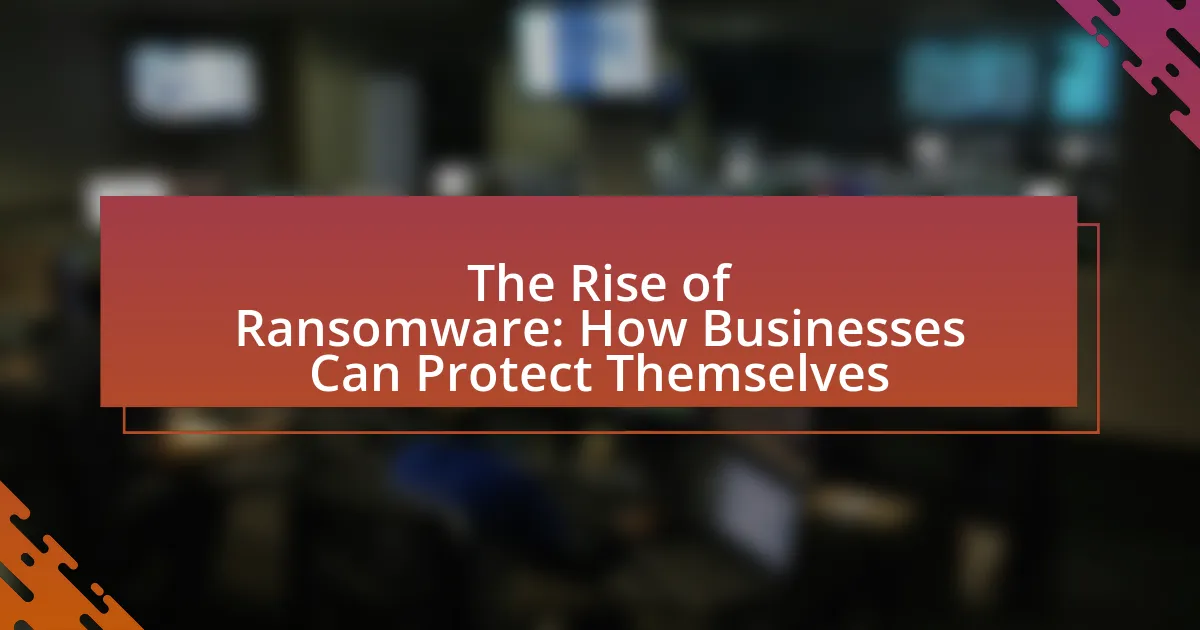Cybersecurity for remote work encompasses the practices and technologies aimed at safeguarding remote employees and their devices from cyber threats while accessing company resources outside traditional office settings. The article highlights the importance of robust cybersecurity measures, as remote workers are significantly more vulnerable to cyberattacks due to unsecured networks and personal devices. Key components of effective cybersecurity include secure access protocols, data protection strategies, device security, and employee training. Additionally, the article outlines best practices for employees, such as strong password management, recognizing phishing attempts, and securing home networks, to enhance their cybersecurity posture while working remotely.

What is Cybersecurity for Remote Work?
Cybersecurity for remote work refers to the practices and technologies designed to protect remote employees and their devices from cyber threats while they access company resources outside of a traditional office environment. This includes implementing secure connections, such as Virtual Private Networks (VPNs), using strong passwords, and ensuring that devices have updated security software. According to a report by Cybersecurity & Infrastructure Security Agency (CISA), remote work increases vulnerability to cyberattacks, making robust cybersecurity measures essential for safeguarding sensitive information and maintaining business continuity.
Why is Cybersecurity Important for Remote Workers?
Cybersecurity is crucial for remote workers because they often access sensitive company data from less secure environments, increasing the risk of data breaches. Remote work setups typically involve personal devices and home networks that may lack robust security measures, making them vulnerable to cyberattacks. According to a report by Cybersecurity & Infrastructure Security Agency (CISA), remote workers are 3 times more likely to experience a cyber incident than those working on-site. This heightened risk underscores the necessity for strong cybersecurity protocols, such as using virtual private networks (VPNs), multi-factor authentication, and regular software updates to protect both personal and organizational information.
What are the unique risks faced by remote employees?
Remote employees face unique risks including cybersecurity threats, isolation, and work-life balance challenges. Cybersecurity threats arise from unsecured home networks and personal devices, making remote workers vulnerable to phishing attacks and data breaches. A report by Cybersecurity & Infrastructure Security Agency indicates that remote work increases the likelihood of cyber incidents due to inadequate security measures. Isolation can lead to decreased mental health and productivity, as remote employees may lack social interaction and support. Additionally, the blurring of boundaries between work and personal life can result in burnout, as employees struggle to disconnect from work responsibilities.
How does remote work increase vulnerability to cyber threats?
Remote work increases vulnerability to cyber threats primarily due to the use of unsecured networks and personal devices. Employees often connect to the internet through home Wi-Fi networks, which may lack robust security measures, making them susceptible to attacks such as eavesdropping and unauthorized access. A report by Cybersecurity & Infrastructure Security Agency (CISA) highlights that 70% of remote workers do not use a Virtual Private Network (VPN), further exposing sensitive data to potential breaches. Additionally, personal devices may not have the same level of security software or updates as corporate devices, increasing the risk of malware infections and data leaks.
What are the key components of Cybersecurity for Remote Work?
The key components of Cybersecurity for Remote Work include secure access, data protection, device security, and employee training. Secure access involves using Virtual Private Networks (VPNs) and multi-factor authentication (MFA) to ensure that only authorized users can access company resources. Data protection encompasses encryption of sensitive information and regular backups to prevent data loss. Device security requires implementing antivirus software and keeping operating systems updated to defend against malware and vulnerabilities. Employee training is essential to educate staff about phishing attacks and safe online practices, which is supported by studies showing that human error is a leading cause of security breaches.
What tools and technologies are essential for remote cybersecurity?
Essential tools and technologies for remote cybersecurity include Virtual Private Networks (VPNs), firewalls, antivirus software, multi-factor authentication (MFA), and endpoint protection solutions. VPNs encrypt internet traffic, ensuring secure connections to remote networks, while firewalls monitor and control incoming and outgoing network traffic based on predetermined security rules. Antivirus software protects against malware and other threats, and MFA adds an extra layer of security by requiring multiple forms of verification before granting access. Endpoint protection solutions safeguard devices used for remote work, detecting and responding to threats in real-time. These tools collectively enhance the security posture of remote work environments, as evidenced by studies showing that organizations employing these technologies experience significantly fewer security breaches.
How do policies and procedures enhance cybersecurity for remote work?
Policies and procedures enhance cybersecurity for remote work by establishing clear guidelines and protocols that employees must follow to protect sensitive information. These frameworks help mitigate risks associated with remote access, such as unauthorized access and data breaches, by defining acceptable use, password management, and incident response strategies. For instance, organizations that implement strong password policies can reduce the likelihood of unauthorized access by ensuring that employees use complex passwords and change them regularly. Additionally, regular training on these policies ensures that employees are aware of potential threats, such as phishing attacks, thereby fostering a culture of security awareness. According to a study by the Ponemon Institute, organizations with comprehensive security policies experience 30% fewer data breaches, highlighting the effectiveness of structured policies in enhancing cybersecurity for remote work.

What Best Practices Should Employees Follow for Cybersecurity?
Employees should follow best practices for cybersecurity by implementing strong password management, utilizing multi-factor authentication, and being vigilant against phishing attacks. Strong passwords should be unique, complex, and changed regularly to reduce the risk of unauthorized access. Multi-factor authentication adds an additional layer of security, making it harder for attackers to gain access even if passwords are compromised. Furthermore, employees must be cautious with emails and links, as phishing attacks accounted for 90% of data breaches in 2020, according to the Verizon Data Breach Investigations Report. By adhering to these practices, employees can significantly enhance their cybersecurity posture while working remotely.
How can employees secure their home networks?
Employees can secure their home networks by implementing strong passwords, enabling network encryption, and regularly updating their router firmware. Strong passwords prevent unauthorized access; for instance, using a combination of letters, numbers, and symbols significantly increases security. Enabling WPA3 encryption on routers protects data transmitted over the network, making it difficult for attackers to intercept information. Regularly updating router firmware addresses vulnerabilities, as manufacturers often release patches to fix security flaws. According to the Cybersecurity & Infrastructure Security Agency (CISA), these practices are essential for maintaining a secure home network and protecting sensitive information while working remotely.
What steps should be taken to configure a secure Wi-Fi network?
To configure a secure Wi-Fi network, first, change the default SSID and password to something unique and complex. This step prevents unauthorized access by making it harder for attackers to guess the network credentials. Next, enable WPA3 encryption, which is currently the most secure Wi-Fi encryption standard, providing robust protection against eavesdropping and unauthorized access. Additionally, disable WPS (Wi-Fi Protected Setup) as it can be exploited to gain access to the network. Regularly update the router’s firmware to patch vulnerabilities and enhance security features. Finally, consider setting up a guest network for visitors to keep the main network isolated, further protecting sensitive devices and data. These steps collectively enhance the security of a Wi-Fi network, reducing the risk of cyber threats.
How can employees ensure their devices are secure?
Employees can ensure their devices are secure by implementing strong passwords, regularly updating software, and using antivirus programs. Strong passwords should be complex and unique for each account, reducing the risk of unauthorized access. Regular software updates patch vulnerabilities, as evidenced by a 2021 report from the Cybersecurity & Infrastructure Security Agency, which highlighted that 85% of successful cyberattacks exploited known vulnerabilities. Additionally, antivirus programs provide real-time protection against malware, further safeguarding devices from threats.
What role does password management play in remote cybersecurity?
Password management is crucial in remote cybersecurity as it helps protect sensitive information from unauthorized access. Effective password management practices, such as using strong, unique passwords for different accounts and regularly updating them, significantly reduce the risk of data breaches. According to a study by Verizon, 81% of hacking-related breaches leverage stolen or weak passwords, highlighting the importance of robust password management in safeguarding remote work environments. By implementing password managers, employees can securely store and generate complex passwords, further enhancing their cybersecurity posture while working remotely.
How can employees create strong passwords?
Employees can create strong passwords by using a combination of at least 12 characters, including uppercase letters, lowercase letters, numbers, and special symbols. This approach significantly increases password complexity, making it harder for unauthorized users to guess or crack them. Research indicates that passwords of this length and complexity can withstand brute-force attacks, which often rely on guessing common or simple passwords. Additionally, employees should avoid using easily obtainable personal information, such as birthdays or names, as these can be exploited by attackers. Implementing unique passwords for different accounts further enhances security, as it prevents a single breach from compromising multiple accounts.
What are the benefits of using password managers?
Using password managers enhances cybersecurity by securely storing and managing complex passwords. They generate strong, unique passwords for each account, reducing the risk of password reuse, which is a common vulnerability. According to a study by the Cybersecurity & Infrastructure Security Agency, 81% of data breaches are linked to weak or stolen passwords. Password managers also facilitate easier access to accounts without the need to remember multiple passwords, thereby encouraging users to adopt stronger security practices. Additionally, many password managers offer features like two-factor authentication and security audits, further bolstering account protection.

How can employees recognize and respond to cyber threats?
Employees can recognize and respond to cyber threats by being vigilant about unusual activities, such as unexpected emails or requests for sensitive information. They should look for signs like poor grammar in communications, unfamiliar sender addresses, or urgent calls to action that seem out of place. To respond effectively, employees must report suspicious activities to their IT department immediately and follow established protocols for handling potential breaches. According to the Cybersecurity & Infrastructure Security Agency (CISA), timely reporting can significantly mitigate the impact of cyber threats, as early detection is crucial in preventing data breaches.
What are common types of cyber threats faced by remote workers?
Common types of cyber threats faced by remote workers include phishing attacks, malware, unsecured Wi-Fi networks, and data breaches. Phishing attacks often target remote workers through deceptive emails or messages that trick them into revealing sensitive information. Malware can be introduced via downloads or email attachments, compromising devices and data. Unsecured Wi-Fi networks pose risks as attackers can intercept data transmitted over these connections. Data breaches can occur when remote workers access company systems without proper security measures, leading to unauthorized access to sensitive information. According to a report by Cybersecurity & Infrastructure Security Agency (CISA), remote work has significantly increased the risk of these threats, highlighting the need for robust cybersecurity practices.
How can phishing attacks be identified and avoided?
Phishing attacks can be identified and avoided by recognizing suspicious emails, messages, or websites that request sensitive information. Employees should look for signs such as poor grammar, generic greetings, and mismatched URLs. According to the Anti-Phishing Working Group, in 2021, 83% of organizations experienced phishing attacks, highlighting the prevalence of this threat. To avoid falling victim, employees should verify the sender’s identity through official channels, refrain from clicking on unknown links, and utilize security software that includes phishing protection features.
What should employees do if they suspect a security breach?
Employees should immediately report any suspected security breach to their organization’s IT or security team. Prompt reporting is crucial as it allows for a swift investigation and mitigation of potential threats. According to the Cybersecurity & Infrastructure Security Agency (CISA), timely reporting can significantly reduce the impact of a breach, as early detection is key to preventing data loss or further exploitation.
How can employees stay informed about cybersecurity trends?
Employees can stay informed about cybersecurity trends by regularly following reputable cybersecurity news sources, participating in training programs, and engaging with professional networks. Reputable sources include websites like Krebs on Security and the Cybersecurity & Infrastructure Security Agency (CISA), which provide timely updates on threats and best practices. Training programs, such as those offered by organizations like SANS Institute, enhance knowledge and skills relevant to current cybersecurity challenges. Additionally, engaging with professional networks, such as the Information Systems Security Association (ISSA), allows employees to share insights and learn from industry experts, ensuring they remain updated on evolving cybersecurity trends.
What resources are available for ongoing cybersecurity education?
Ongoing cybersecurity education resources include online courses, certifications, webinars, and industry conferences. Platforms such as Coursera, edX, and Cybrary offer courses on various cybersecurity topics, while certifications from organizations like CompTIA, (ISC)², and SANS Institute provide structured learning paths. Additionally, webinars hosted by cybersecurity firms and organizations like the Cybersecurity and Infrastructure Security Agency (CISA) offer current insights and best practices. Industry conferences, such as Black Hat and DEF CON, provide networking opportunities and access to the latest research and trends in cybersecurity. These resources are essential for professionals to stay updated in a rapidly evolving field.
How can employees participate in cybersecurity training programs?
Employees can participate in cybersecurity training programs by enrolling in company-sponsored training sessions, attending workshops, or completing online courses. Many organizations provide structured training modules that cover essential cybersecurity practices, such as recognizing phishing attempts and securing personal devices. According to a report by the Ponemon Institute, organizations that implement regular cybersecurity training can reduce the risk of data breaches by up to 70%. This statistic underscores the importance of employee participation in such programs to enhance overall security awareness and compliance within the workplace.
What are practical tips for maintaining cybersecurity while working remotely?
To maintain cybersecurity while working remotely, employees should implement strong password practices, use secure connections, and regularly update software. Strong passwords, which include a mix of letters, numbers, and symbols, reduce the risk of unauthorized access; according to a 2021 study by the Cybersecurity & Infrastructure Security Agency, 81% of data breaches are linked to weak passwords. Utilizing Virtual Private Networks (VPNs) ensures that data transmitted over the internet is encrypted, protecting sensitive information from interception. Regular software updates are crucial as they patch vulnerabilities that cybercriminals exploit; the National Institute of Standards and Technology emphasizes that outdated software is a common entry point for attacks. Additionally, employees should be cautious of phishing attempts and verify the authenticity of emails before clicking on links or downloading attachments.




